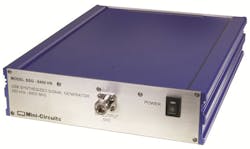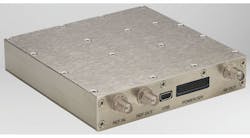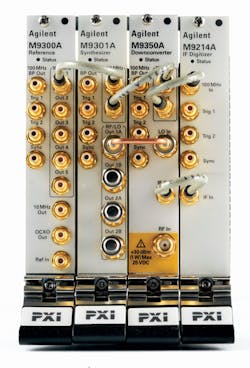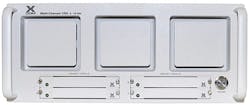This file type includes high resolution graphics and schematics when applicable.
Competition and innovation can drive new product development as much as market demands. Year after year in the high-frequency-electronics industry, manufacturers large and small have designed creative electronic products that can help solve problems and/or provide performance levels previously unattainable. In recognition of some of these most significant developments, Microwaves & RF has collected some of 2013’s most noteworthy products as a way of paying tribute to the design teams at these companies. These top products are listed in alphabetical order at the end of the article. They are by no means are the only excellent RF/microwave products introduced during the year but, rather, a sampling of the innovations that continually drive this industry.
The Top Products of 2013 include active and passive components, integrated circuits (ICs), and test equipment of interest to engineers in a wide range of markets, from consumer and commercial to industrial and military areas. The products represent older traditional technologies as well as their newer, more experimental counterparts.
For example, a regular contributor to this Top Products list, Micro Lambda Wireless, continued to advance one of this industry’s older technologies—yttrium-iron-garnet (YIG) oscillators—by miniaturizing the components to fit within surface-mount housings. The firm’s MLSMO Series permanent-magnet YIG-tuned oscillators are supplied in TO-8 surface-mount packages measuring only 0.50 in. high.
The oscillators incorporate silicon-germanium (SiGe) active devices for good low-noise performance and are available for bands within the 2-to-13 GHz range. Oscillators operating to 8 GHz are capable of +8 dBm output power and worst-case phase noise of -103 dBc/Hz offset 10 kHz from the carrier and -128 dBc/Hz offset 100 kHz from the carrier. The TO-8 YIG oscillator models measure 0.7 x 0.7 x 0.562 in.—or a fraction of the size of traditional coaxial-packaged YIG oscillator—while still providing the excellent spectral purity that has made YIG oscillators the sources of choice for many high-frequency applications.
In terms of a newer, more revolutionary technology, the IC circuits fabricated at HYPRES are designed for use at cold temperatures. The Josephson-junction-based analog and digital circuits can be produced in high-density formats using a six-layer superconducting circuit process. The firm has used the process to create analog-to-digital converters (ADCs) capable of 100-dB spurious-free dynamic range (SFDR) while operating at clock rates to 30 GHz. The superconducting process uses niobium-based substrate materials and can realize chips with 250-nm resolution limits. In addition, the superconducting technology has enabled digital-signal-processing (DSP) components at clock rates exceeding 100 GHz. Of course, these are devices that require cryocoolers to achieve the required operating temperatures, from 4 to 80 K.
More and more, wireless communications products face the challenges of covering multiple frequency bands, and designers must find ways to serve those different bands with the smallest circuitry possible. To save space, Synergy Microwave Corp. introduced its lines of multiple-band oscillators, which are capable of covering two or more frequency ranges for multiple-band, multiple-function wireless products. The new class of oscillators employs multicoupled planar resonators (MCPRs) to synchronously generate different frequencies for different bands, without multipliers or switching from among resonators. For example, the firm’s reconfigurable concurrent oscillators (RCOs) can produce multiple wireless-local-area-network (WLAN) signals from a single 8-GHz VCO, helping to miniature the final design of a multiple-band WLAN radio (such as a 2.45/5-GHz product).
Although the introduction of passive components may not always generate the excitement of active components like oscillators, circuit elements such as capacitors are vital to many active and passive components. AVX took a giant step forward in 2013 with its multilayer organic (MLO™) capacitors . Based on the firm’s multilayer passive circuit technology, which can be used for capacitors, inductors, crossovers, and diplexers, these capacitors can be mounted miniature package sizes on printed-circuit boards (PCBs) operating through 20 GHz.
MLO capacitors are fabricated in 0603 package size with ratings of 50, 250, and 500 V and consistent quality factor (Q) values for capacitances to 5.1 pF. They are fabricated with lead-free, RoHS-compliant circuit materials fashioned with geometries from 10 to 75 μm. The MLO capacitors, inductors, and other passive components feature a coefficient of thermal expansion (CTE) that is closely matched to that of popular PCB materials to ensure high reliability over wide operating temperature ranges.
At a somewhat higher level of integration, the BGTx0 family of millimeter-wave transceiver ICs from Infineon Technologies are single-chip devices that combine receivers and transmitters for mobile backhaul applications at 60, 70, and 80 GHz. The firm’s model BGT60 covers V-band frequencies from 57 to 65 GHz. The model BGT70 transceiver works from 71 to 76 GHz, while the model BGT80 is for E-band frequencies from 81 to 88 GHz.
Based on the company’s silicon-germanium (SiGe) semiconductor technology, which offers a transition frequency to 200 GHz, these devices use an SPI bus for control of transmit and receive functions. They are housed in the same pin and package configurations, and employ a direct-conversion, zero-intermediate-frequency (zero-IF) transceiver configuration for simple connection within modems and baseband circuits. Each transceiver can replace more than 10 discrete components, with a corresponding reduction in power consumption compared to the discrete-component approach.
Also at a higher level of integration, but larger due to discrete components, the model FSL-0010 frequency synthesizer from Phase Matrix nonetheless measures just 4.0 x 4.0 x 0.8 in. and covers 0.65 to 10.00 GHz (Fig. 1). This latest addition to the company’s QuickSyn® line of modular frequency synthesizers includes Universal-Serial-Bus (USB) and serial-peripheral-interface (SPI) connectors for control with a personal computer (PC). It tunes with 0.001-Hz frequency resolution and 100-μs switching speed in triggered list mode (selecting from as many as 32,000 points) and 200-μs switching speed under the control of individual SPI commands.
With at least +15 dBm output power, the phase noise is typically -126 dBc/Hz offset 1 kHz from a 0.65-GHz carrier and typically -104 dBc/Hz offset 1 kHz from a 10-GHz carrier. The phase noise drops to -138 dBc/Hz offset 10 kHz from a 0.65-GHz carrier and typically -117 dBc/Hz offset 10 kHz from a 10-GHz carrier. Spurious levels are controlled to at least -60 dBc and are typically -70 dBc. The FSL-0010 operates from a +12-VDC supply with nominal power consumption of only 11 W.
This file type includes high resolution graphics and schematics when applicable.
VNAs And More
This file type includes high resolution graphics and schematics when applicable.
Advancing the capabilities of vector network analyzers (VNAs), Anritsu Co. introduced its MS4640B series of RF/microwave VNAs with a suite of automatic pulsed measurements (Fig. 2). When equipped with Options 035 and 042 (PulseView™), the MS4640B series VNAs can generate and analyze fast pulsed signals and perform pulse profiling, point-in-pulse measurements, and pulse-to-pulse measurements. The analyzers are available in different models with frequency coverage from 70 kHz to 110 GHz, and with pulse resolution of 2.5 ns across a dynamic range of 100 dB.
Although long associated with rack-mount test equipment, Agilent Technologies continued to make advances into more compact, modular test instruments with the introduction of its model M9391A vector signal analyzer (VSA) in PXI Express (PXIe) format (Fig. 3). It provides as much as 160-MHz analysis bandwidth in versions from 1 MHz to 3 GHz or 1 MHz to 6 GHz. It is so compact that four of the VSAs can be housed in a single 18-slot PXI chassis.
For creating phase-coherent signals for testing modern systems, the VSG5000A vector signal generators (VSGs) from X-COM Systems can tune from 50 MHz to 3 GHz and from 6 to 18 GHz with 1-Hz resolution, with each generator providing four independent channels (Fig. 4). The sources produce as much as +5 dBm output power across maximum channel bandwidths of 110 MHz, with phase noise of only -84 dBc/Hz offset 1 kHz from the carrier and -135 dBc/Hz offset 1 MHz from the carrier.
For portable testing, the RoHS-compliant model SSG-6400HS synthesized signal generator from Mini-Circuits covers a range of 250 kHz to 6400 MHz with output-power levels of -75 to +10 dBm (Fig. 5). It measures just 11.00 x 8.50 x 2.15 in. with a Type-N, 50-Ω female coaxial output connector. The SSG-6400HS signal generator can be tuned with typical frequency resolution of better than 0.01 Hz across the full frequency range, with frequency accuracy of ±1.5 ppm when using its own internal frequency reference. It switches frequencies with better than 300 μs tuning speed and supports clean connections with RF/microwave cables via typical VSWR of 1.20:1 through 6400 MHz. It can be controlled remotely via a personal computer (PC) via its built-in USB port or a TCP/IP Ethernet connection.
The portable signal generator achieves excellent spectral performance, with second harmonics of typically -40 dBc through 4000 MHz and typically -25 dBc at higher frequencies. The nonharmonic spurious levels are typically -70 dBc through 3000 MHz and typically -60 dBc through 6400 MHz. Phase noise is typically -133 dBc/Hz offset 10 kHz from a 1000-MHz carrier and -144 dBc/Hz offset 1 MHz from a 1000-MHz carrier. It is typically -123 dBc/Hz offset 10 kHz from a 3000-MHz carrier and -134 dBc/Hz offset 1 MHz from a 3000-MHz carrier.
The phase noise is typically -117 dBc/Hz offset 10 kHz from a 6000-MHz carrier and -128 dBc/Hz offset 1 MHz from a 6000-MHz carrier. The compact signal generator is supplied with a 12-V AC/DC 12-V adapter, an AC power cord, a USB cable, and a compact disc (CD) containing the GUI control program, plus programming APIs for 32- and 64 b programming environments.
For enhanced control over testing through millimeter-wave frequencies, the RSC family of testers from Rohde & Schwarz is available with step attenuators capable of operating to 67 GHz. Controllable manually or remotely, the step attenuators are available over different frequency ranges, including 18 and 67 GHz. As an example, one unit provides a 139-dB attenuation range in 1-dB steps through 6 GHz, while another version operates to 18 GHz with 115-dB maximum attenuation and 5-dB steps. Two base models capable of operation to 40 and 67 GHz and maximum attenuation of 75 dB in 5-dB steps.
Somewhere between systems and test, the CHAMP-WB-DRFM high-speed single-board digitizer jointly introduced by Curtiss-Wright and Tektronix Component Solutions provides reliable capture of the many different types of signals found in defense systems from DC to 6 GHz. The board uses an analog-to-digital converter (ADC) from Tektronix capable of sampling at 12 GSamples/s. It employs a 12-GSamples/s digital-to-analog converter (DAC) and Virtex-7 field-programmable gate array (FPGA) from Xilinx, also working at 12 GSamples/s. The single-board digitizer is suitable for use in electronic-intelligence (ELINT), electronic-warfare (EW), radar, and signal-intelligence (SIGINT) applications.
This file type includes high resolution graphics and schematics when applicable.
Top Products Of 2013 (Listed Alphabetically)
This file type includes high resolution graphics and schematics when applicable.
Agilent Technologies’ model M9391A PXIe vector signal analyzer (October)
Anritsu Co.’s MS4640B series of VNAs with pulsed measurement capabilities (October)
AVX’s MLO passive component process (online only)
Curtiss-Wright’s CHAMP-WB-DRFM single-board digitizer (October Defense Electronics supplement)
HYPRES’s six-layer superconducting circuit process (August)
Infineon Technologies’ BGTx0 family of millimeter-wave transceiver ICs (June)
Micro Lambda’s surface-mount YIG oscillators (March)
Related Articles
• Top 2012 Products Blend Value and Performance
• Top Products Of 2011
• Top Products of 2010
Mini-Circuits’ model SSG-6400HS synthesized signal generator (July)
Phase Matrix’s low-cost frequency synthesizers (September)
Rohde & Schwarz’s RSC test units and attenuators (online only)
Synergy Microwave’s multiple-band oscillators (May)
X-COM Systems’ model VSG5000A vector signal generators (July)
This file type includes high resolution graphics and schematics when applicable.
About the Author
Jack Browne
Technical Contributor
Jack Browne, Technical Contributor, has worked in technical publishing for over 30 years. He managed the content and production of three technical journals while at the American Institute of Physics, including Medical Physics and the Journal of Vacuum Science & Technology. He has been a Publisher and Editor for Penton Media, started the firm’s Wireless Symposium & Exhibition trade show in 1993, and currently serves as Technical Contributor for that company's Microwaves & RF magazine. Browne, who holds a BS in Mathematics from City College of New York and BA degrees in English and Philosophy from Fordham University, is a member of the IEEE.






